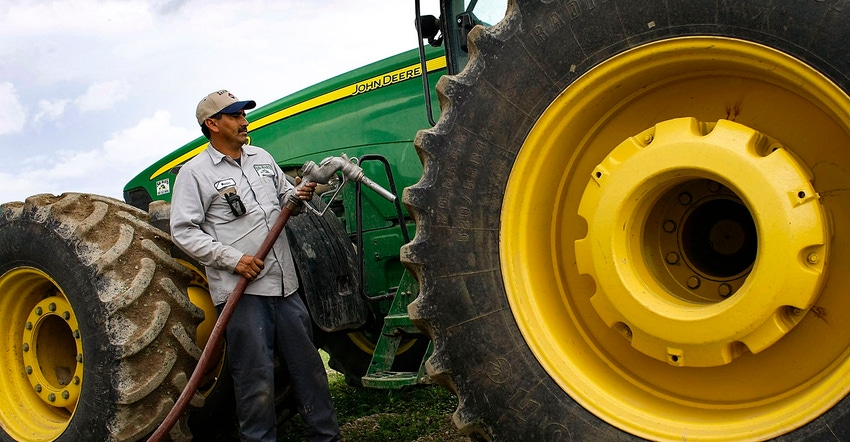
It’s easy to fall into old habits – especially during the height of busy times on the farm. With such tight farm margins in 2022, however, it will be well worth your while to consider small changes to contribute to reduced farm expenses. Let’s consider fuel.
Diesel fuel prices saw their highest levels ever in recent weeks. According to the April 11 weekly gasoline and diesel fuel update by the United States Energy Information Administration, highway diesel fuel prices nationwide were averaging $5.07 a gallon, up almost $2.00 since this time in 2021. Gasoline reached a national average of $4.09/gal, up $1.24 compared to a year ago.
“This current rise in diesel fuel prices in the U.S. is due to several converging factors,” explains Allen Schaeffer, Executive Director of the Diesel Technology Forum. High crude oil costs, lower U.S. production from the pandemic and refining shutdowns, and low stockpiles and inventories are all contributing to the high prices.
“The fundamentals for higher diesel fuel prices were already in place before the war in Ukraine and countries cutting off energy supplies with Russia,” says Shaeffer. “That just added initial volatility to the situation.”
So what can you do on your operation to protect your farm’s fuel budget? Here are some tips to reduce your fuel bill.
Match equipment to the task
We all have that favorite tractor. But reverting to that same tractor for each job around the farm could be siphoning potential profit. Be sure you're choosing the piece of equipment from your lineup that is best suited for each task.
Running a smaller tractor at high engine speeds for long periods of time will use more fuel than running a larger tractor with more horsepower at lower engine speeds. Operate equipment in the highest gear possible and reduce engine RPMs to reduce fuel consumption. In other words, gear up and throttle down.
Proper maintenance
No matter which piece of equipment you choose, check to see that it’s had a recent tune-up. Change the oil and check tire pressures regularly.
Air filters are often neglected maintenance items, but Schaeffer says they can make a big difference for fuel efficiency.
“Banging the filter on the ground to remove debris is not enough after a while,” he says. “Get a new one!”
Shut it down
Whether it’s a tractor or your farm truck, shut it don’t when it’s not in use.
“We often get distracted and a quick one minute turns into half an hour,” Schaeffer says. “Idling can waste about half a gallon of fuel an hour in some larger equipment.” Over the course of a year, that really adds up.
Time for an upgrade?
The used equipment market is quite lucrative right now. If you have equipment on the farm that is less fuel efficient and you’re considering an upgrade, now might be the time to jump – if you can find what you’re looking for.
Generally, newer vehicles and equipment have better fuel efficiency technology than older generations.
Inspect fuel storage system
Storage tanks can lose a considerable amount of fuel through leaks and evaporation. Carefully and frequently check your system for cracks and leaks – and repair as needed. Store tanks in the shade, paint them white, and upgrade to vacuum release caps.
While you’re at it, ensure gasoline and diesel storage tanks are properly labeled, and keep a dry chemical fire extinguisher nearby.
Choose the right fuel
Fuel is expensive enough – don’t spend money on a grade of fuel you don’t actually need.
When it comes to diesel, choose blends of high-quality biodiesel fuels when possible. “Biodiesel or renewable diesel fuels might be less in price than traditional petroleum diesel,” Schaeffer says. “Check with your tractor dealer to make sure, but most tractors are suitable for blends of biodiesel fuels up to B20, which displaces 20% of petroleum fuel.”
Where are fuel prices headed?
Future price considerations are riddled with uncertainty, especially given the current global climate.
“Prices are moderating in the next 12 months to $4.04/gallon of highway diesel, down from record $5.00 + highs, but not fully back down to lower pre-pandemic levels,” says Schaeffer.
Schaeffer adds that seasonal price swings for diesel are somewhat predictable. A cold winter requires more oil for home heating, which competes with diesel fuel for trucking and farming interests. Farming diesel demand peaks occur in spring and fall.
The war in Ukraine, the production decisions of the Organization of the Petroleum Exporting Countries, and the rate at which U.S. oil and natural gas producers increase drilling could all tip the scale on where prices head in the future.
About the Author(s)
You May Also Like






